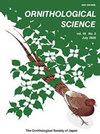Nesting Characteristics and Breeding Success of Rose-Ringed Parakeet Psittacula krameri in Urban and Natural Areas
IF 0.3
4区 生物学
Q4 ORNITHOLOGY
引用次数: 2
Abstract
Abstract The present study was conducted to identify the effect of urban and natural areas on nesting and breeding success of Rose-ringed Parakeet. Nests of Rose-ringed Parakeet were monitored using a combination of camera surveillance and direct observations along transect lines. Cavity availability and use was compared between natural and urban areas. A total of 171 cavities were located, of which 106 contained active nests. The number of available cavities and the proportion occupied were both higher in natural areas than in urban areas. A uniform/cosine model estimated that mean nest density was greater (P<0.05) in natural areas (136 nests/km2) than in urban areas (130 nests/km2). The preferred trees used for nesting were Banyan Ficus benghalensis (22.8%) followed by Chinaberry Tree Melia azedarach (20.4%), Paper Mulberry Broussonetia papyrifera (14.6%), Chir Pine Pinus roxburghii (14.6%), Southern Blue Gum Eucalyptus globulus (11%), Mango Mangifera indica (9.3%), and White Mulberry Morus alba (12%). The greatest number (P<0.05) of successful breeding cavities was recorded in the middle of trees (42.5%) at heights of 6.1–9 m (72.6%) above ground. Mean cavity depths were significantly greater (P<0.05) in urban areas (9.95±0.5 cm) than in natural areas (8.71±2.1 cm), while mean entrance diameter was 6.19±1.9 cm in natural areas and 5.65±0.2 cm in urban areas. Clutches of five eggs were the most common. Hatchling and fledgling successes were higher in natural areas than urban areas, with egg survival probability (70.0%) and nestling survival probability (94.0%) higher in natural areas than in urban areas (37% and 60%) respectively. It is concluded that the breeding success of Rose-ringed Parakeet varies between urban and natural areas.城市和自然地区玫瑰环长尾小鹦鹉的筑巢特征和繁殖成功
摘要本研究旨在确定城市和自然地区对玫瑰环长尾鹦鹉筑巢和繁殖成功的影响。玫瑰环长尾鹦鹉的巢是使用相机监测和沿样线直接观察相结合的方法监测的。比较了自然和城市地区的洞穴可用性和使用情况。共发现171个洞穴,其中106个洞穴中有活动巢穴。自然地区的可用洞穴数量和占用比例都高于城市地区。均匀/余弦模型估计,自然地区(136个巢穴/km2)的平均巢穴密度大于城市地区(130个巢穴/kkm2)(P<0.05)。用于筑巢的首选树木是榕树(22.8%),其次是紫檀(20.4%)、纸桑树构树(14.6%)、刺梨松(146%)、南方蓝胶蓝桉(11%)、芒果(9.3%)和白桑树(12%)。在地面以上6.1–9米(72.6%)的高度,树木中间(42.5%)的繁殖腔数量最多(P<0.05)。城市地区的平均空腔深度(9.95±0.5 cm)明显大于自然地区(8.71±2.1 cm)(P<0.05),而自然地区和城市地区的入口平均直径分别为6.19±1.9 cm和5.65±0.2 cm。最常见的是五枚鸡蛋。自然地区的孵化和雏鸟成功率高于城市地区,自然地区的卵存活率(70.0%)和巢存活率(94.0%)分别高于城市地区(37%和60%)。得出的结论是,玫瑰环长尾鹦鹉的繁殖成功率因城市和自然地区而异。
本文章由计算机程序翻译,如有差异,请以英文原文为准。
求助全文
约1分钟内获得全文
求助全文
来源期刊

Ornithological Science
ORNITHOLOGY-
CiteScore
1.20
自引率
0.00%
发文量
26
审稿时长
>12 weeks
期刊介绍:
Ornithological Science publishes reviews, original articles, short communications and comments covering all aspects of ornithology. Manuscripts are judged on the basis of their contribution of original data and ideas or interpretation. All articles are peer-reviewed by at least two researchers expert in the field of the submitted paper. Manuscript are edited where necessary for clarify and economy. Ornithological Science aims to publish as rapidly as is consistent with the requirements of peer-review and normal publishing constraints.
 求助内容:
求助内容: 应助结果提醒方式:
应助结果提醒方式:


